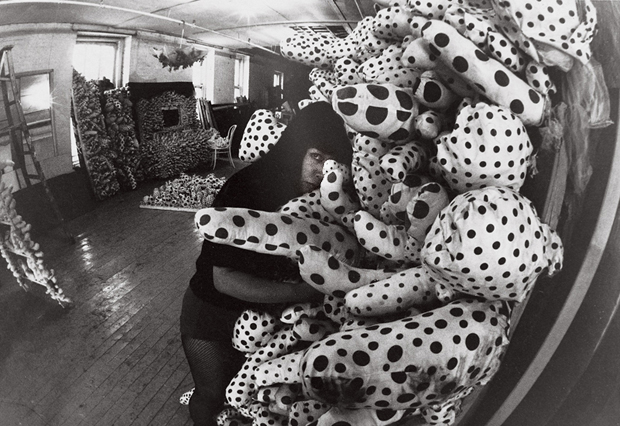
Kusama: 'I promised myself I'd conquer the world'
A rare video interview with Yayoi Kusama and part two of our chat with Tate Modern curator Frances Morris
Today we bring you the second half of our interview with Frances Morris, the woman who's put together the massive Yayoi Kusama retrospective that opens at Tate Modern on Thursday (9) and runs until June 7. You can read the first part of the interview here. In it Morris, the Tate's Head of Collections, International Art, talks about the artist's early days in Japan, how she came to America to find Georgia O'Keefe and eventually became radicalised and then burnt out by the New York art scene of the late Sixties - and how she pre-empted Damien Hirst by helping mastermind the enterprise culture around art. (Kusama set up a fashion house, wrote adverts for herself and masterminded her image theatrically and brilliantly). There is also an extremely rare and iluminating video interview with Kusama herself at the bottom of today's story.
Morris was intimately involved in the process of choosing the works for the Tate show from the hundreds of thousands of pieces Kusama has created over seven decades of intense work. Towards the end of part one of the interview Frances talked about Kusama’s decision to reside in a mental institution since the 70s.
“She is somebody who evidently from childhood onward has suffered from various neuroses, anxieties, depressive episodes, suicidal thoughts so there is an admittance of a kind of fragility in her mental health, or however one likes to put it. I think it’s an incredible demonstration of the way she has brilliantly controlled that. She has a very keen awareness of her own vulnerabilities and that demonstrates enormous strength. I think she hasn’t allowed her vulnerabilities to compromise her evident talent. She’s ploughed the strengths and the weaknesses that she was born with into her work.
 Yayoi Kusama, I'm Here, but Nothing (2000/2012)
Yayoi Kusama, I'm Here, but Nothing (2000/2012)You’re a big fan of her early work, what do you get from it?
I do find the small works on paper from the Fifties and Sixties has this world in a grain of sand, this minute but galactic quality to it. When looking, you have that feeling of, ‘my God what scale am I?’ You get lost in this extraordinary cosmos and then are taken aback when you consider that they’re only four inches wide. I think these macroscopic realms are really extraordinary. And they’re incredibly beautiful. I was completely stunned when I first saw them. I think it’s extraordinary that somebody so young, so far away and brought up in such a traditional environment was so able to absorb the influence of Miro and Ernst and Klee whose work she probably only saw in reproduction, then taking it all on and going on to produce work of such originality and in such great quantity. What I love is the idea that all the dayglo “brandiness” of her spots all comes back to this incredible energy from her early twenties.
What’s she like to work with?
Ha! Well, she’s very, very small and very, very intimidating! She’s pretty tough. Completely inscrutable. I must say that once the show was resolved, in terms of selection, the subsequent visits were lighter and happier. But it hasn’t been a breeze. I’ve had to argue the case and I think probably to begin with she just wanted to think about recent work so to get her to agree to this broader survey was a bit of a journey. Like a lot of artists, the most recent work is what she’s preoccupied by, therefore she wants to share that with people. She’s not particularly interested about being put into art history and being stood up and compared with other artists.
__ Interesting, because she’s such a part of it__
You said it. She’s so part of it. And the work is so embedded in context but she doesn’t want to be put back into the box of art history and stood up and compared to other artists. She wants to stand alone. She’s such a self-invented creature. I tried to explain to her that that uniqueness would only be enhanced by comparison with others.
 Yayoi Kusama, Aggregation: One Thousand Boats Show (1963)
Yayoi Kusama, Aggregation: One Thousand Boats Show (1963)How does that present itself now? She once offered to sleep with Nixon if he’d stop the Vietnam War. Has Obama had any letters?
Ha, I think she’s less engaged with people now than she was then. Obviously that singularity is very much in evidence in the way she dresses and in her poetry and in the way she presents herself to the world. She’s always been self-promotional. She had herself photographed by great photographers from the age of 15. She wanted to be in the spot. There are very few photos of Kusama with other people. And she was willing to take her clothes off for the camera at a very early stage!
And finally, what was the thing that surprised you most about her?
Most of all was when I first went to see her and I was asked if I could be filmed by a television crew who were making a documentary. So I said ‘fine’. And then it was explained to me that they are always there. So this continuous documentation of her own history I find fascinating. But to have every conversation recorded for posterity made it quite challenging. There was one moment when I did insist on privacy, which was difficult to achieve!”
Read part one of the interview here.
Watch Yayoi Kusama talk about her life in the video below.
Read more about Yayoi Kusama:
Yayoi Kusama designs London tube map
To infinity and beyond with Yayoi Kusama
Sign up to the Phaidon newsletter to get future updates.